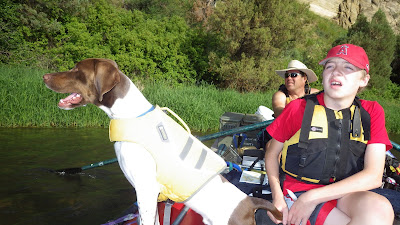 |
| Pair of bald eagles in flight (courtesy Gordan Hardcastle) |
 |
| Wood ducks and golden-eye in flight (courtesy Gordan Hardcastle) |
 |
| A variety of ducks take flight at the Hagerman WMA (click to enlarge) |
 |
| Red-tailed hawk in the morning sun |
 |
| Bald eagles near the Westpoint store/cafe ... 12 in one tree! |
I wanted to share a blog post I wrote this week for Southern Idaho Tourism about viewing bald eagles, waterfowl and other birds near Wendell and Hagerman right now. In a matter of two hours, I saw more than 35 bald eagles near Wendell in the early morning hours last Saturday ... and I saw a ton of ducks and geese at the Hagerman Wildlife Management Area.
I love to see bald eagles, so it was a thrill to see so many birds in a short amount of time. See the blog post for driving directions and a map. It's only 1.25 hours to the Hagerman area via I-84 when the roads are dry. There also is a birding list of all the birds you can see in the area right now. Make sure you bring your binoculars, camera and a bird book!
While you're in the 'hood, think about visiting Miracle Hot Springs after you go eagle- and bird-watching ... that'd make for one heck of a great day! Top it off with a meal at the Snake River Grill in Hagerman. The restaurant is famous for it's exotic menu and excellent food!
What a humdinger of a snow storm last night! Brundage and Bogus got more than 16 inches of snow, and the lucky folks who were in position to go powder skiing today had a bonanza! Both areas needed more snow after all the ski traffic they've been receiving ... and more is on the way this weekend!
A couple of tidbits:
Chadd Cripe's feature story on pond hockey in Ketchum in the Idaho Statesman got a lot of hits when I shared it on my Facebook page. I'm a pond hockey player from way back when in Minnesota. Tuck this one away for future reference in case you might be able to field a team for next year's event! Or you can just reminisce about playing pond hockey!
Lift ticket discount for bus riders at Bogus: If you ride the bus to Bogus, you'll get a $10 discount on your lift ticket. Everyone knows that parking can be a challenge at Bogus, especially on busy days, so if you have the flexibility to ride the bus everyone benefits! Here's more information on bus transportation to Bogus.
River applications are due at the end of January for the Middle Fork of the Salmon River, Main Salmon River, Selway River and Hells Canyon. Go to recreation.gov to fill out the form and submit your application.
Have a great weekend!
- SS





















